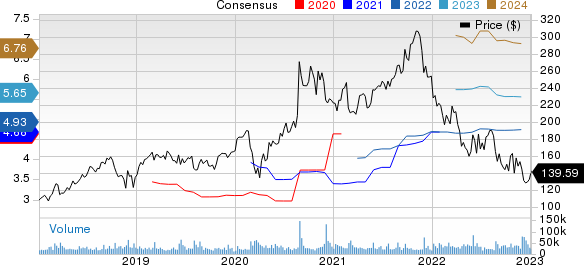Salesforce (CRM) to Slash Operating Costs, Reduce Staff by 10%
Salesforce CRM announced to lay off approximately 10% of its total global workforce, exit real estate and shutdown office spaces in certain markets as part of its broader Restructuring Plan to help the company improve its profitability.
Filing with the Securities and Exchange Commission (SEC) in Jan 4, the company revealed that the Restructuring Plan has been designed to “reduce operating costs, improve operating margins, and continue advancing the Company’s ongoing commitment to profitable growth.”
Notably, computer software companies like Salesforce were among the strong beneficiaries of the pandemic-induced demand boom for cloud-based services from businesses looking to operate amid lockdowns. Salesforce hired aggressively in the last two years to capitalize on the opportunity.
However, with the reopening of economies, the demand for such services has started to moderate, slowing the growth rate of Salesforce. Additionally, growing global slowdown concerns amid the current macroeconomic challenges and geopolitical tensions have led the enterprise to push back its IT spending plans.
Salesforce Inc. Price and Consensus

Salesforce Inc. price-consensus-chart | Salesforce Inc. Quote
We believe that the aforementioned issues have triggered such a move by Salesforce to focus more on margins.
Salesforce’s current restructuring plan will include $1.0-$1.4 billion in charges for employee transition, severance payments, employee benefits and share-based compensation, as well as $450-$650 million in exit charges related to the office space reductions. The San Francisco-based company expects to incur $1.4-$2.1 billion in charges over its restructuring plan, of which $800 million to $1.0 billion is expected to be completed by the end of fourth-quarter fiscal 2023.
The Customer Relationship Management software leader expects the majority of employee-restructuring related process to be completed by the end of fiscal 2024 and the real estate restructuring related process to be closed by the end of fiscal 2026. However, the estimated period might get extended due to different local laws and consultation requirements in various jurisdictions in which Salesforce operates.
In the third quarter of 2023, CRM’s non-GAAP income from operations stood at $1.78 million compared with$1.36 million in third-quarter 2022. For fiscal 2023, the company expects non-GAAP operating margin of 20.7%.
Third-quarter revenues were $7.84 billion, indicating a 14% year-over-year rise. An aggressive sales strategy drove the top line at the cost of its profitability as the gross margins remained flat at 73% in third-quarter fiscal 2023. As of Jan 31, 2022, the company’s employee count was 73,541 compared to 56,606 as of Jan 31, 2021.
Salesforce's fourth-quarter fiscal 2023 revenue guidance of $7.932-$8.032 billion (mid-point $7.982 billion) includes a $250-million negative impact of unfavorable currency exchange rates. For fiscal 2023, the company expects the stronger U.S. dollar against other major currencies to have a $900-million negative impact on total revenues, which is estimated to be $30.9-$31 billion. Salesforce reduced the year-over-year operating cash flow growth projection to 16% from the earlier stated 16-17%.
In the post-pandemic era, tech giants, such as Amazon AMZN, Twitter, Netflix NFLX and Uber Technologies UBER have also sacked staff, witnessing a slump in demand for their products.
Recently, Amazon revealed that it intends to lay off more than 18,000 positions to reduce operating costs starting from Jan 18. Since November 2022, the company has already axed about 10,000 employees. As of Sep 30, 2022, AMZN’s employee count was 1.54 million compared with 1.47 million as of Sep 30, 2021.
In July, Twitter declared the layoff of 30% of workers from its human resource department to cut costs. The restructuring of the talent acquisition workforce was in response to the shifting business requirements of the company.
In June, Netflix sacked 300 employees in the second round of job cuts after losing subscribers for the first time in more than a decade. The reduction was about 4% of the streaming giant’s workforce and mostly affected U.S. employees. This came after the company cut 150 jobs in May.
Before that, in May, Uber reportedly reduced its spending and slowed down hiring due to a seismic shift in investor sentiment, through a reduction in staff. In order to better serve its shareholders and their long-term interests, the company aimed to make its business model leaner by cutting down expenses on marketing and incentive.
Currently, Salesforce has a Zacks Rank #2 (Buy), while Netflix and Uber carry a Zacks Rank #3 (Hold). Amazon has a Zacks Rank #5 (Strong Sell). Shares of CRM, AMZN, NFLX and UBER have plunged 38.7%, 48.2%, 45.5% and 40.1%, respectively, in the past year.
You can see the complete list of today's Zacks #1 Rank (Strong Buy) stocks here.
Want the latest recommendations from Zacks Investment Research? Today, you can download 7 Best Stocks for the Next 30 Days. Click to get this free report
Amazon.com, Inc. (AMZN) : Free Stock Analysis Report
Salesforce Inc. (CRM) : Free Stock Analysis Report
Netflix, Inc. (NFLX) : Free Stock Analysis Report
Uber Technologies, Inc. (UBER) : Free Stock Analysis Report
